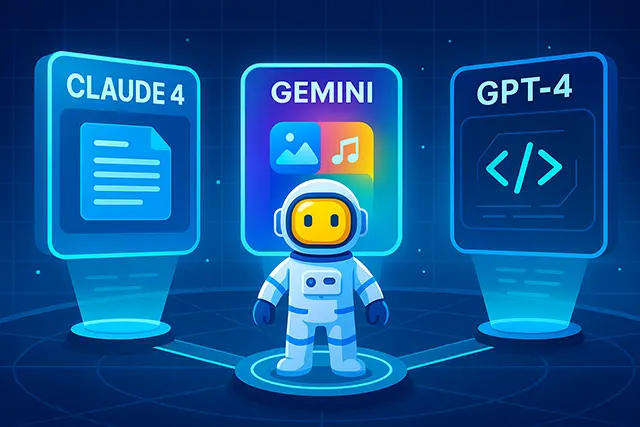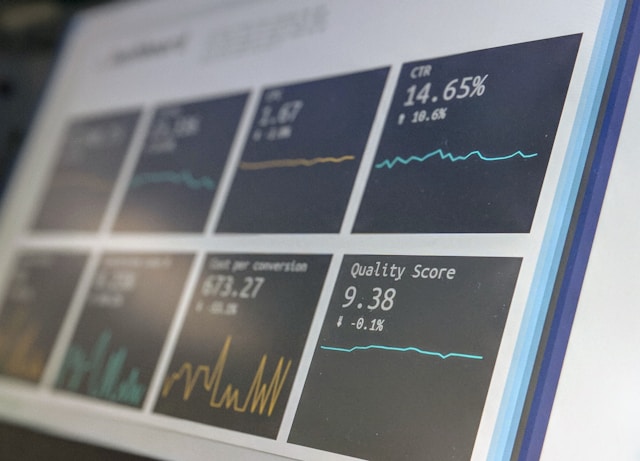Claude 4 vs Gemini vs GPT-4: Best Model for Your Business

Let’s be honest keeping up with AI models in 2025 is like trying to pick a smartphone every year. There’s always something newer, better, or more hyped. But when it comes to choosing the best AI model for your business, the stakes are way higher. The decision impacts not just how your team operates, but how customers experience your brand and how scalable your infrastructure really is.
So, what are your options if you’re searching for the best AI model for business use?
Right now, three major players dominate the scene: Claude 4, Gemini, and GPT-4. You’ve probably heard of at least one or maybe even used them without realizing. But the big question remains: Claude 4 vs Gemini vs GPT-4 what’s actually the best model for your business needs?
Here’s a no-nonsense breakdown to help you decide.
Table of Contents
Claude 4 vs Gemini vs GPT-4: Overview of the Models
You ever look at three tools that claim to solve the same problem and just think yeah, these aren’t built for the same person? That’s exactly how it feels with Claude 4, Gemini, and GPT-4. Each one is engineered with a different mindset, by companies with wildly different philosophies. Comparing them side-by-side only works if we acknowledge that we’re not dealing with variations of the same idea we’re looking at three totally separate visions for what AI should be and how it should work in business.
Claude 4 – Constitutional AI and a Focus on Safety
Imagine working with someone who always reads the fine print, triple-checks the facts, and politely refuses to cross a gray line that’s Claude 4. It’s the AI equivalent of that one dependable team member who might not be flashy, but you trust them with sensitive work every single time.
Built by Anthropic, Claude 4 doesn’t just aim to be helpful it’s explicitly designed not to cause harm. This is where its “constitutional” foundation comes in. It follows a written set of ethical rules to guide its behavior, which sounds nerdy, sure, but in real-world use, it means you can rely on it not to spin off into wild, hallucinated responses when the stakes are high.
And here’s something practical: its 200K token context window is massive. If you’ve ever tried feeding legal documents or multi-step instructions into a model, you’ll appreciate that it doesn’t choke on length or complexity. Claude just gets it.
In one project we tested, Claude consistently gave the most grounded summaries less fluff, more substance. Some might call it dry. We call it trustworthy.
Bonus points: it plays surprisingly well with Make.com and other workflow tools, which means you can put it to work automating reports, cleaning up client notes, or handling customer messages without worrying it’ll go off-script.
Gemini – Google’s Multimodal Powerhouse
Gemini feels like something Google built for itself and then generously decided to share. It’s slick, polished, and packed with potential, especially if your team is already knee-deep in Google Workspace. Think Gmail, Docs, Sheets, Meet Gemini weaves itself into all of it.
But here’s the real kicker: Gemini doesn’t just do text. It can process images, audio, even video inputs. That kind of multimodal capability is a game-changer if you’re dealing with customer support tickets that include screenshots, product reviews with images, or meetings recorded as voice memos.
Is it perfect? Not always. You might find that its responses sometimes need a bit of massaging, especially on open-ended tasks. But when it works, it feels like magic.
GPT-4 – OpenAI’s Versatile Generalist
If Claude is the careful one and Gemini is the media-savvy type, GPT-4 is the creative problem solver the kind of teammate who can write code, summarize a legal document, and brainstorm your next product slogan, all before lunch.
Chances are you’ve already bumped into GPT-4 in the wild. It powers ChatGPT, GitHub Copilot, and lots of the AI tools people casually use every day. But the version developers get access to is even more powerful especially with GPT-4o in the picture now, which brings voice and vision into the mix.
Where GPT-4 really shines is in flexibility. You want to fine-tune prompts, build chatbots, or chain together complex tasks? It can do all of that. And with its massive plugin ecosystem and memory-enabled GPTs, it’s the model of choice for devs, startups, and innovation teams.
Model Capabilities That Actually Impact Your Workflow
Forget flashy demos what really matters is how these models perform on the job.
Language Understanding and Output Quality
Claude is the most precise when it comes to tone and intent. It doesn’t ramble, it doesn’t hallucinate much, and it tends to keep things clear. Ideal for legal, HR, or healthcare documents where one wrong word could mean trouble.
GPT-4 can be more verbose, but that’s not always a bad thing it’s great for brainstorming, blog writing, or detailed explanations. Gemini? Fast and to the point, but sometimes cuts corners in long-form tasks.
Multimodal Input and Tool Use
Gemini leads the pack here. It can handle video, audio, images, and text all at once. For media-heavy workflows think marketing, product reviews, or creative briefs it’s a solid pick.
GPT-4o has caught up fast, offering real-time multimodal capabilities. Claude doesn’t support images or audio (yet), but it’s the best at following detailed written instructions and parsing structured documents like reports or spreadsheets.
Business Integration, Ecosystem, and API Access
How well these models integrate into your stack can make or break your team’s productivity.
Claude 4 – Built for Secure Workflows
Claude shines in secure, structured environments. Its API is straightforward and great for summarization or RAG (retrieval augmented generation). You can plug it into Notion, Slack, or your favorite automation tool like Make.com.
It’s especially suited for businesses in finance, legal, or healthcare.
GPT-4 – The Developer’s Playground
GPT-4 is a favorite for teams building their own AI tools. The plugin support, system message customization, and memory features let you build smarter, persistent assistants.
If you want to experiment, iterate fast, and scale, GPT-4 delivers. The Claude 4 API Integration Guide offers insights that apply here too.
Gemini – Best Fit for Google Ecosystems
Gemini’s tight integration with Google Cloud and Workspace means setup is a breeze. It works great with BigQuery, Drive, Gmail, and more.
If your infrastructure is already Google-heavy, Gemini is the least disruptive choice.
Fine-Tuning, Customization, and Prompt Engineering
Prompt Responsiveness + Accuracy
Claude is sharp. It sticks to the prompt and refuses off-topic or harmful content with grace. It’s like a well-trained assistant that knows what not to say.
GPT-4 is a bit looser but more creative. Want a haiku, a code snippet, and a marketing pitch in one go? GPT-4 delivers. Gemini lands somewhere in the middle: powerful, but sometimes needs parameter tweaking.
Which Model Is Easiest to Control?
Claude is the most controlled almost too careful at times. GPT-4 gives you a lot of flexibility, but you’ll need some guardrails. Gemini has great potential but doesn’t yet give you full reins outside the Google ecosystem.
Cost, Speed, and Scalability for Business Use
Here’s what each model will cost you in API usage as of 2025:
| Model | Input Price (per 1M tokens) | Output Price (per 1M tokens) | Notes |
|---|---|---|---|
| Claude 4 Opus | $15.00 | $75.00 | High safety, 200K token window (source) |
| Gemini 1.5 Pro | $1.25 | $5.00 | Google Cloud-native (source) |
| GPT-4o | $2.00 | $8.00 | Fast, multimodal, cost-efficient (source) |
Claude is the premium option best for when safety and context depth matter more than budget. GPT-4o is a solid all-rounder. Gemini is the budget-friendly option, especially if you’re already on Google Cloud.
Privacy, Compliance, and Security
If data privacy is high on your checklist, Claude 4 is a top pick. Anthropic doesn’t use your data for training, and their refusal mechanics are built for compliance.
GPT-4 Enterprise includes encryption and isolation, though OpenAI does store data unless opted out. Gemini’s deep ties with Google raise some eyebrows in privacy circles fine for most teams, but not the best fit for regulated industries.
So, Which One Should You Use?
Claude 4: Best for Compliance-Heavy Workflows
If you need precision, tone safety, and reliable refusal behavior, Claude 4 for Writers is hard to beat.
Gemini: Best for Multimodal Google Users
Already living in the Google ecosystem? Gemini will slot right in and offer powerful multimedia handling.
GPT-4: Best for Dev Teams and Creative Flexibility
You’re building tools? Need flexibility and power? GPT-4 (and GPT-4o) is the obvious choice.
Final Thoughts
There’s no single best model only the best fit for your team, your stack, and your priorities. Claude is careful and corporate-friendly. Gemini is slick and visual. GPT-4 is broad, powerful, and customizable.
In fact, many companies are already blending models through platforms like Make.com. Claude writes summaries, GPT-4 builds the chatbot, Gemini handles visual content.
In 2025, AI isn’t one tool. It’s an ecosystem and picking the right set of tools is the real game-changer.







